stop start HONDA CIVIC COUPE 2015 9.G Owners Manual
[x] Cancel search | Manufacturer: HONDA, Model Year: 2015, Model line: CIVIC COUPE, Model: HONDA CIVIC COUPE 2015 9.GPages: 441, PDF Size: 18.4 MB
Page 5 of 441
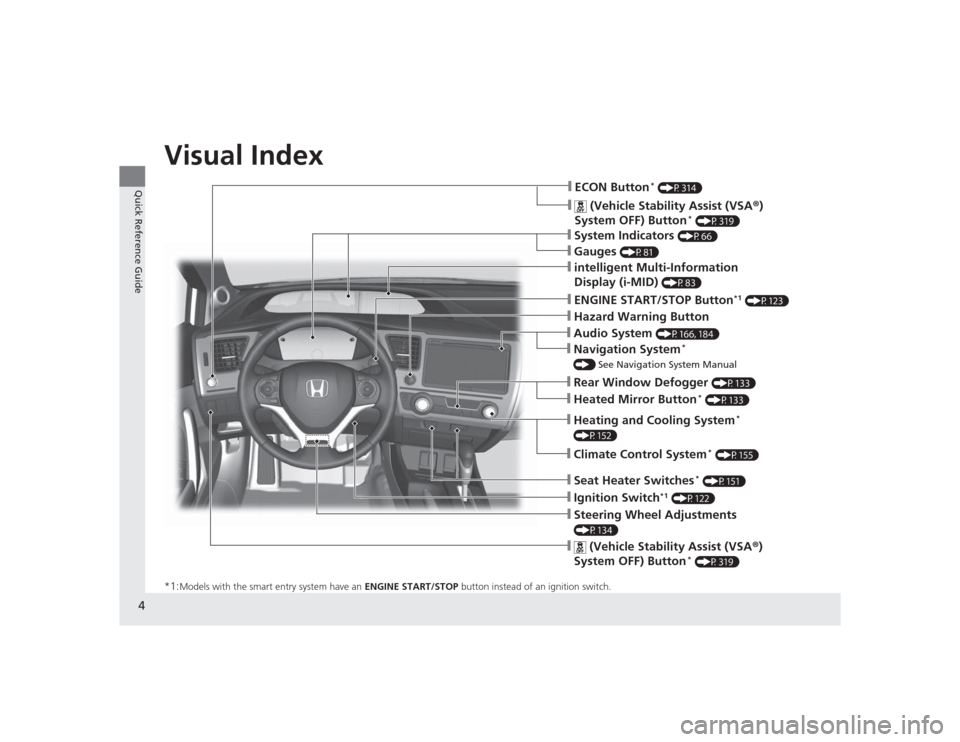
4Quick Reference Guide
Quick Reference GuideVisual Index*1:
Models with the smart entry system have an ENGINE START/STOP button instead of an ignition switch.
❙Hazard Warning Button❙Seat Heater Switches
* (P151)
❙Ignition Switch
*1 (P122)
âť™
(Vehicle Stability Assist (VSA ®)
System OFF) Button
* (P319)
❙ECON Button
* (P314)
âť™
(Vehicle Stability Assist (VSA ®)
System OFF) Button
* (P319)
❙Steering Wheel Adjustments (P134)❙Navigation System
*
() See Navigation System Manual❙Audio System
(P166, 184)
❙Rear Window Defogger
(P133)
❙Heated Mirror Button
* (P133)
❙Heating and Cooling System
*
(P152)❙Climate Control System
* (P155)
❙intelligent Multi-Information
Display (i-MID)
(P83)
❙ENGINE START/STOP Button
*1 (P123)
❙System Indicators
(P66)
❙Gauges
(P81)
Page 13 of 441
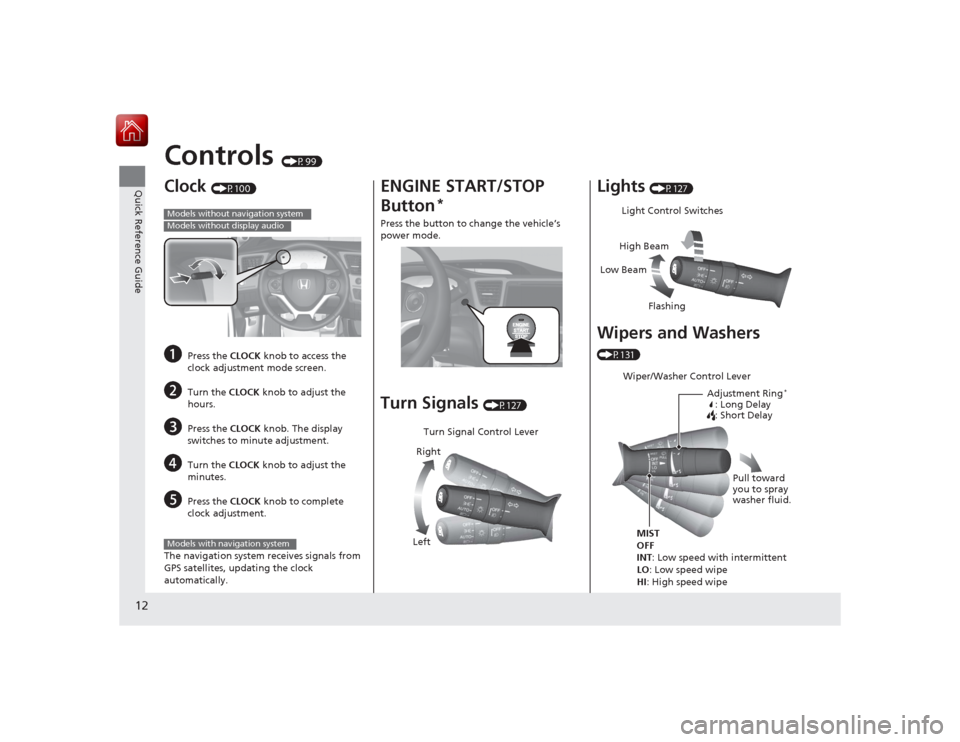
12Quick Reference Guide
Controls
(P99)
Clock
(P100)
a
Press the CLOCK knob to access the
clock adjustment mode screen.
b
Turn the CLOCK knob to adjust the
hours.
c
Press the CLOCK knob. The display
switches to minute adjustment.
d
Turn the CLOCK knob to adjust the
minutes.
e
Press the CLOCK knob to complete
clock adjustment.
The navigation system receives signals from
GPS satellites, updating the clock
automatically.
Models without navigation systemModels without display audioModels with navigation system
ENGINE START/STOP
Button
*
Press the button to change the vehicle’s
power mode.Turn Signals
(P127)
Turn Signal Control Lever
Right
Left
Lights
(P127)
Wipers and Washers (P131)
Light Control Switches
Low Beam High Beam
FlashingWiper/Washer Control Lever Adjustment Ring
*
: Long Delay
: Short Delay
MIST
OFF
INT: Low speed with intermittent
LO: Low speed wipe
HI: High speed wipe Pull toward
you to spray
washer fluid.
Page 14 of 441
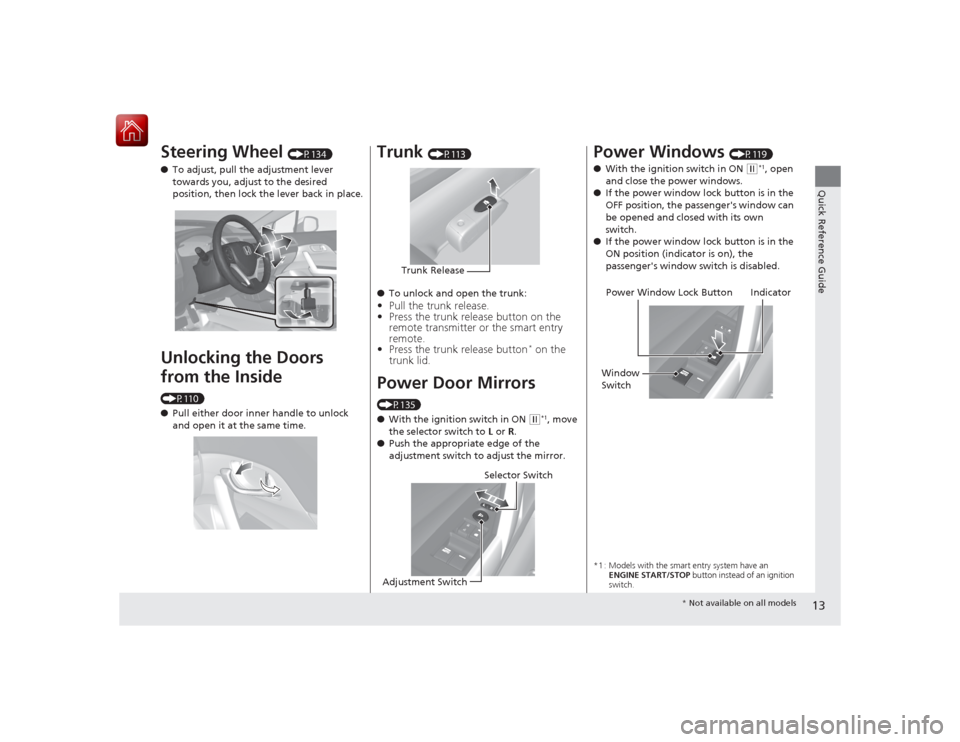
13Quick Reference Guide
Steering Wheel
(P134)
â—Ź To adjust, pull th e adjustment lever
towards you, adjust to the desired
position, then lock the lever back in place.
Unlocking the Doors
from the Inside (P110)
â—Ź Pull either door inner handle to unlock
and open it at the same time.
Trunk
(P113)
â—Ź To unlock and open the trunk:
•Pull the trunk release.
• Press the trunk release button on the
remote transmitter or the smart entry
remote.
• Press the trunk release button
* on the
trunk lid.
Power Door Mirrors (P135)
â—Ź With the ignition switch in ON
(w*1, move
the selector switch to L or R .
â—Ź Push the appropriate edge of the
adjustment switch to adjust the mirror.
Trunk Release
Selector Switch
Adjustment Switch
Power Windows
(P119)
â—Ź With the ignition switch in ON
(w*1, open
and close the power windows.
â—Ź If the power window lock button is in the
OFF position, the passenger's window can
be opened and closed with its own
switch.
â—Ź If the power window lock button is in the
ON position (indicator is on), the
passenger's window switch is disabled.
*1 : Models with the smart entry system have an
ENGINE START/STOP button instead of an ignition
switch.
Power Window Lock Button
Window
Switch Indicator
*
Not available on all models
Page 23 of 441
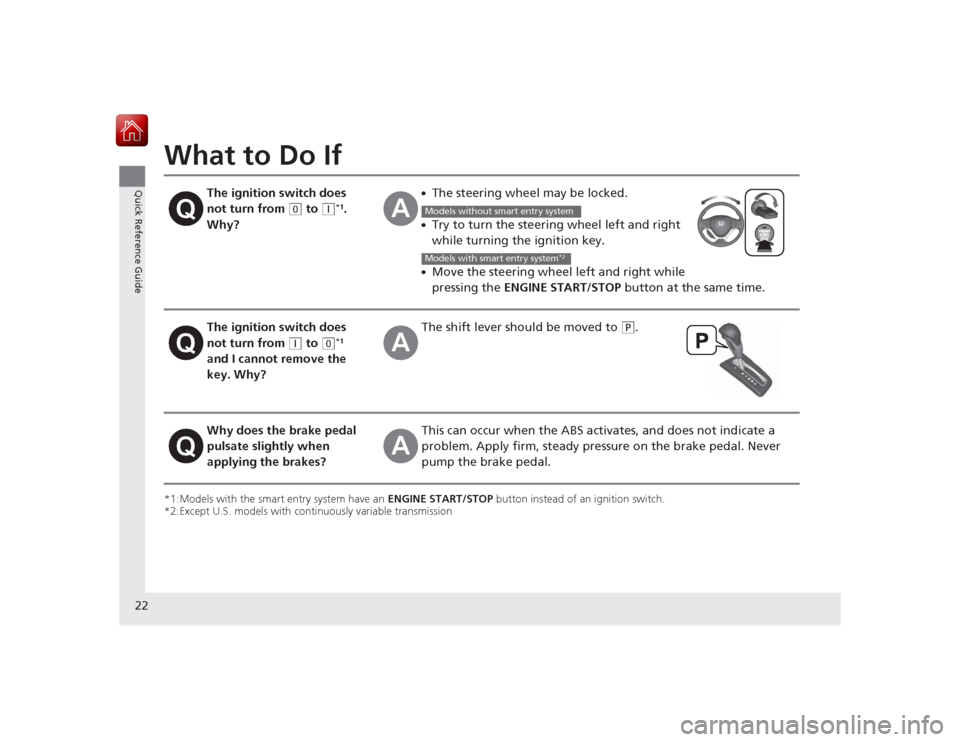
22Quick Reference Guide
What to Do If*1:Models with the smart entry system have an ENGINE START/STOP button instead of an ignition switch.
*2:Except U.S. models with continuously variable transmission
The ignition switch does
not turn from
(0
to
(q
*1.
Why?
â—ŹThe steering wheel may be locked.â—ŹTry to turn the steering wheel left and right
while turning the ignition key.â—ŹMove the steering wheel left and right while
pressing the ENGINE START/STOP button at the same time.
The ignition switch does
not turn from
(q
to
(0
*1
and I cannot remove the
key. Why?
The shift lever s hould be moved to
(P
.
Why does the brake pedal
pulsate slightly when
applying the brakes?
This can occur when the ABS act ivates, and does not indicate a
problem. Apply firm, steady pressure on the brake pedal. Never
pump the brake pedal.Models without smart entry systemModels with smart entry system
*2
Page 32 of 441
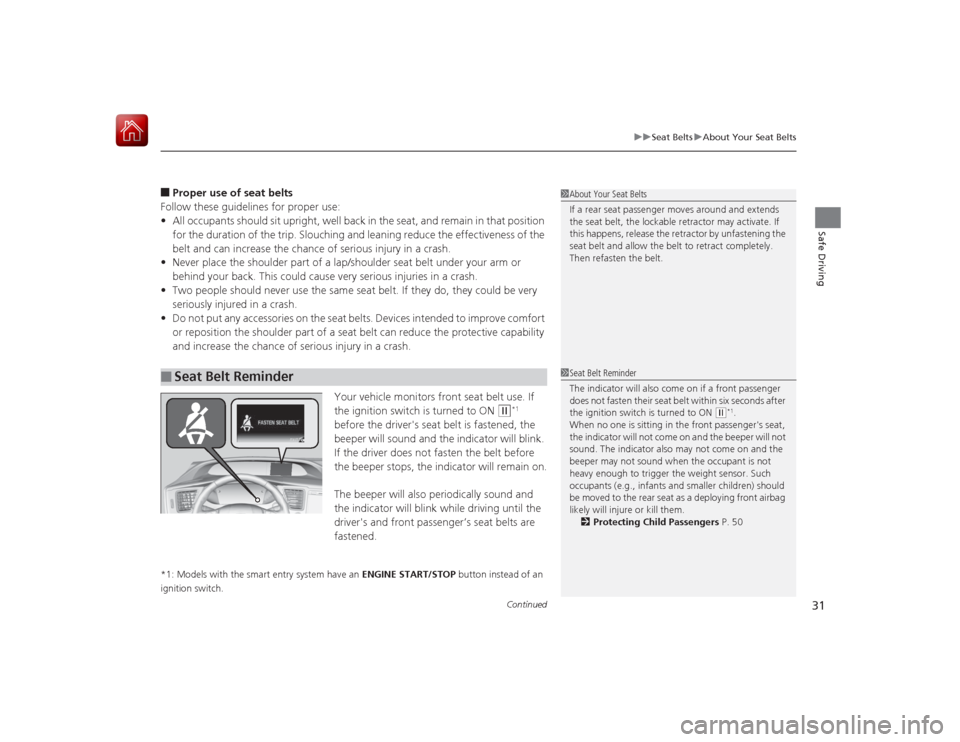
Continued
31
uuSeat Belts uAbout Your Seat Belts
Safe Driving
â– Proper use of seat belts
Follow these guidelines for proper use:
• All occupants should sit upright, well back in the seat, and remain in that position
for the duration of the trip. Slouching and leaning reduce the effectiveness of the
belt and can increase the chance of serious injury in a crash.
• Never place the shoulder part of a lap/sh oulder seat belt under your arm or
behind your back. This could ca use very serious injuries in a crash.
• Two people should never use the same seat belt. If they do, they could be very
seriously injured in a crash.
• Do not put any accessories on the seat belts. Devices intended to improve comfort
or reposition the shoulder part of a seat belt can reduce the protective capability
and increase the chance of serious injury in a crash.
Your vehicle monitors front seat belt use. If
the ignition switch is turned to ON
(w
*1
before the driver's seat belt is fastened, the
beeper will sound and the indicator will blink.
If the driver does not fasten the belt before
the beeper stops, the indicator will remain on.
The beeper will also periodically sound and
the indicator will blink while driving until the
driver's and front passenger’s seat belts are
fastened.
*1: Models with the smart entry system have an ENGINE START/STOP button instead of an
ignition switch.â–
Seat Belt Reminder
1 About Your Seat Belts
If a rear seat passenger moves around and extends
the seat belt, the lockable retractor may activate. If
this happens, release the retractor by unfastening the
seat belt and allow the belt to retract completely.
Then refasten the belt.1 Seat Belt Reminder
The indicator will also come on if a front passenger
does not fasten their seat b elt within six seconds after
the ignition switch is turned to ON
( w*1.
When no one is sitting in the front passenger's seat,
the indicator will not come on and the beeper will not
sound. The indicator also may not come on and the
beeper may not sound when the occupant is not
heavy enough to trigger the weight sensor. Such
occupants (e.g., infants and smaller children) should
be moved to the rear seat as a deploying front airbag
likely will injure or kill them. 2 Protecting Child Passengers P. 50
Page 39 of 441
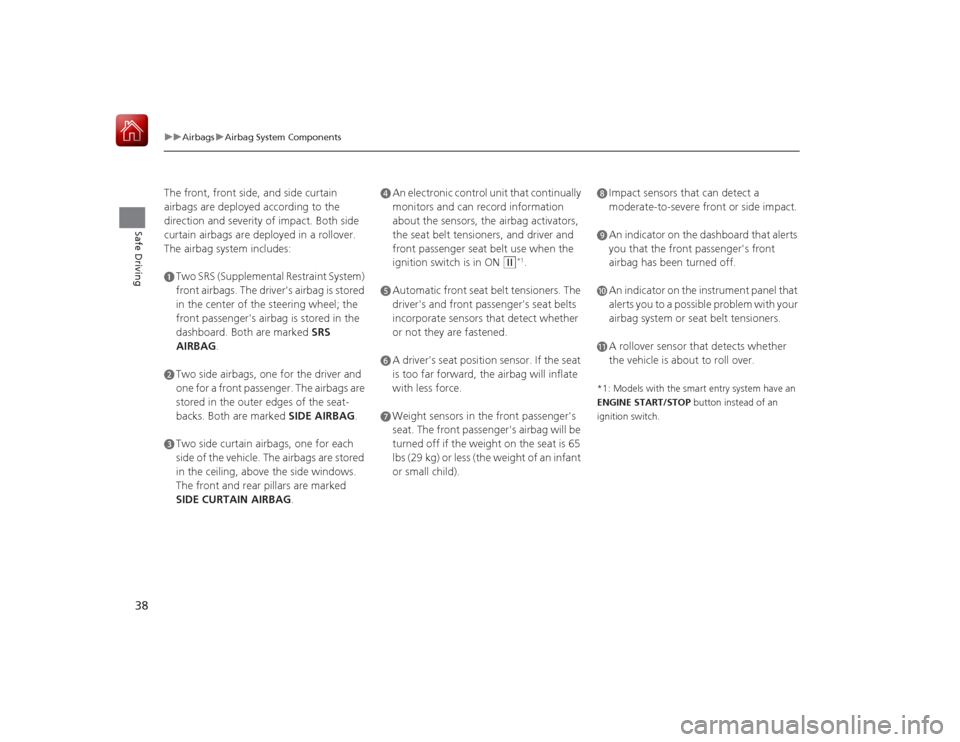
38
uuAirbags uAirbag System Components
Safe Driving
The front, front side, and side curtain
airbags are deployed according to the
direction and severity of impact. Both side
curtain airbags are deployed in a rollover.
The airbag system includes:aTwo SRS (Supplemental Restraint System)
front airbags. The driver's airbag is stored
in the center of the steering wheel; the
front passenger's airbag is stored in the
dashboard. Both are marked SRS
AIRBAG.bTwo side airbags, one for the driver and
one for a front passenger. The airbags are
stored in the outer edges of the seat-
backs. Both are marked SIDE AIRBAG .cTwo side curtain airbags, one for each
side of the vehicle. The airbags are stored
in the ceiling, above the side windows.
The front and rear pillars are marked
SIDE CURTAIN AIRBAG.
dAn electronic control unit that continually
monitors and can record information
about the sensors, the airbag activators,
the seat belt tensioners, and driver and
front passenger seat belt use when the
ignition switch is in ON
(w
*1.
eAutomatic front seat belt tensioners. The
driver's and front passenger's seat belts
incorporate sensors that detect whether
or not they are fastened.fA driver's seat position sensor. If the seat
is too far forward, the airbag will inflate
with less force.gWeight sensors in the front passenger's
seat. The front passenger's airbag will be
turned off if the weight on the seat is 65
lbs (29 kg) or less (the weight of an infant
or small child).
hImpact sensors that can detect a
moderate-to-severe front or side impact.iAn indicator on the dashboard that alerts
you that the front passenger's front
airbag has been turned off.jAn indicator on the instrument panel that
alerts you to a possible problem with your
airbag system or seat belt tensioners.kA rollover sensor that detects whether
the vehicle is about to roll over.*1: Models with the smart entry system have an
ENGINE START/STOP button instead of an
ignition switch.
Page 41 of 441
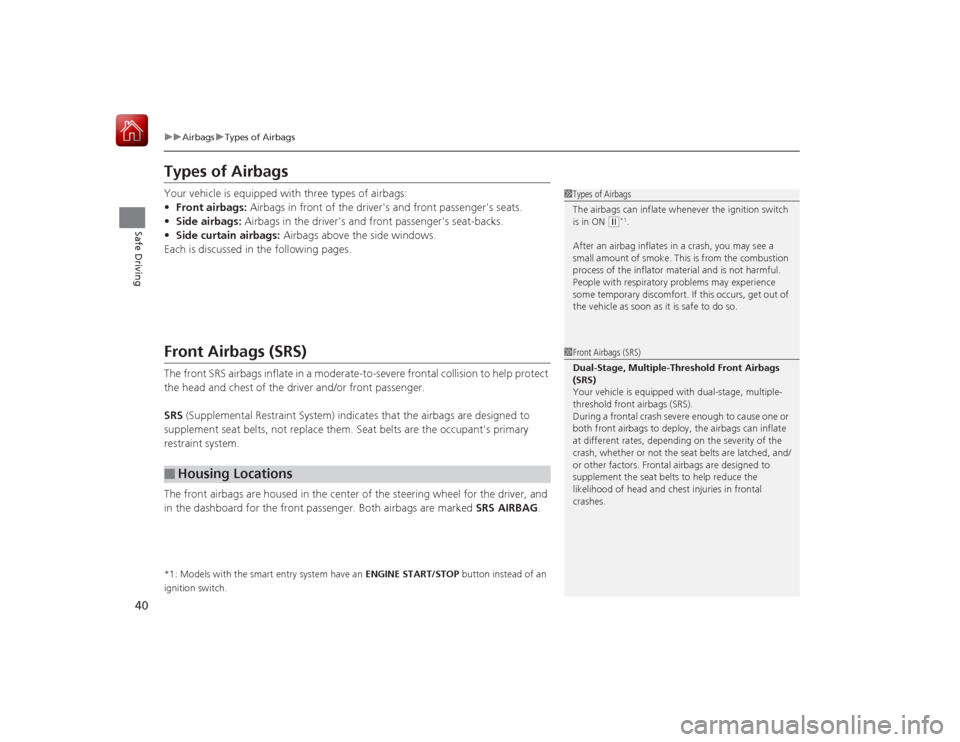
40
uuAirbags uTypes of Airbags
Safe Driving
Types of AirbagsYour vehicle is equipped with three types of airbags:
• Front airbags: Airbags in front of the driver's and front passenger's seats.
• Side airbags: Airbags in the driver's and front passenger's seat-backs.
• Side curtain airbags: Airbags above the side windows.
Each is discussed in the following pages.Front Airbags (SRS)The front SRS airbags inflate in a moderate-to-severe frontal collision to help protect
the head and chest of the driver and/or front passenger.
SRS (Supplemental Restraint System) indicates that the airbags are designed to
supplement seat belts, not replace them. Seat belts are the occupant's primary
restraint system.
The front airbags are housed in the center of the steering wheel for the driver, and
in the dashboard for the front passenger. Both airbags are marked SRS AIRBAG.*1: Models with the smart entry system have an ENGINE START/STOP button instead of an
ignition switch.â–
Housing Locations
1 Types of Airbags
The airbags can inflate whenever the ignition switch
is in ON
(w*1.
After an airbag inflates in a crash, you may see a
small amount of smoke. This is from the combustion
process of the inflator ma terial and is not harmful.
People with respiratory problems may experience
some temporary discomfort. If this occurs, get out of
the vehicle as soon as it is safe to do so.
1 Front Airbags (SRS)
Dual-Stage, Multiple-Threshold Front Airbags
(SRS)
Your vehicle is equipped with dual-stage, multiple-
threshold front airbags (SRS).
During a frontal crash severe enough to cause one or
both front airbags to deploy, the airbags can inflate
at different rates, depending on the severity of the
crash, whether or not the seat belts are latched, and/
or other factors. Frontal airbags are designed to
supplement the seat belts to help reduce the
likelihood of head and chest injuries in frontal
crashes.
Page 48 of 441
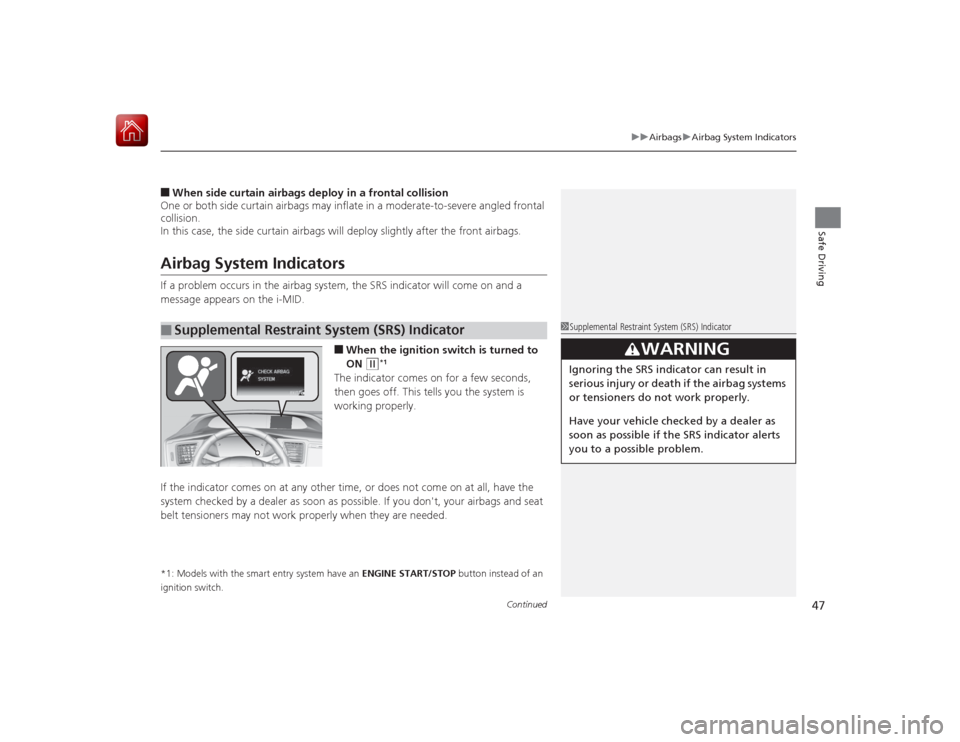
Continued
47
uuAirbags uAirbag System Indicators
Safe Driving
â– When side curtain airbags de ploy in a frontal collision
One or both side curtain airbags may inflate in a moderate-to-severe angled frontal
collision.
In this case, the side curtain airbags will deploy slightly after the front airbags.Airbag System IndicatorsIf a problem occurs in the airbag system, the SRS indicator will come on and a
message appears on the i-MID.
â– When the ignition switch is turned to
ON
(w
*1
The indicator comes on for a few seconds,
then goes off. This tells you the system is
working properly.
If the indicator comes on at any other time, or does not come on at all, have the
system checked by a dealer as soon as possible. If you don't, your airbags and seat
belt tensioners may not work properly when they are needed.
*1: Models with the smart entry system have an ENGINE START/STOP button instead of an
ignition switch.â–
Supplemental Restraint System (SRS) Indicator
1Supplemental Restraint System (SRS) Indicator
3
WARNING
Ignoring the SRS indicator can result in
serious injury or death if the airbag systems
or tensioners do not work properly.
Have your vehicle checked by a dealer as
soon as possible if the SRS indicator alerts
you to a possible problem.
Page 67 of 441

66Instrument Panel
Indicators*1:Models with the smart entry system have an ENGINE START/STOP button instead of an ignition switch.Indicator
Name
On/Blinking
Explanation
Message
Parking Brake
and Brake
System Indicator
(Red)
â—ŹComes on for a few seconds when
you turn the ignition switch to ON (w
*1, then goes off if the parking
brake has been released.
â—ŹComes on when the parking brake
is applied, and goes off when it is
released.â—ŹComes on when the brake fluid
level is low.â—ŹComes on if there is a problem
with the brake system.â—ŹThe beeper sounds and the
indicator comes on if you drive
with the parking brake not fully
released.
â—ŹComes on while driving - Make sure
the parking brake is released. Check the
brake fluid level.
2 What to do when the indicator
comes on while driving P. 411
â—ŹComes on along with the ABS
indicator - Have your vehicle checked by
a dealer.
2 If the Brake System Indicator (Red)
Comes On P. 411
Brake System
Indicator
(Amber)
â—ŹComes on for a few seconds when
you turn the ignition switch to ON (w
*1, then goes off.
â—ŹComes on if there is a problem
with a component related to
braking.
â—ŹStays on constantly - Have your vehicle
checked by a dealer.
U.SCanada(Red)U.SCanada(Amber)
Page 68 of 441
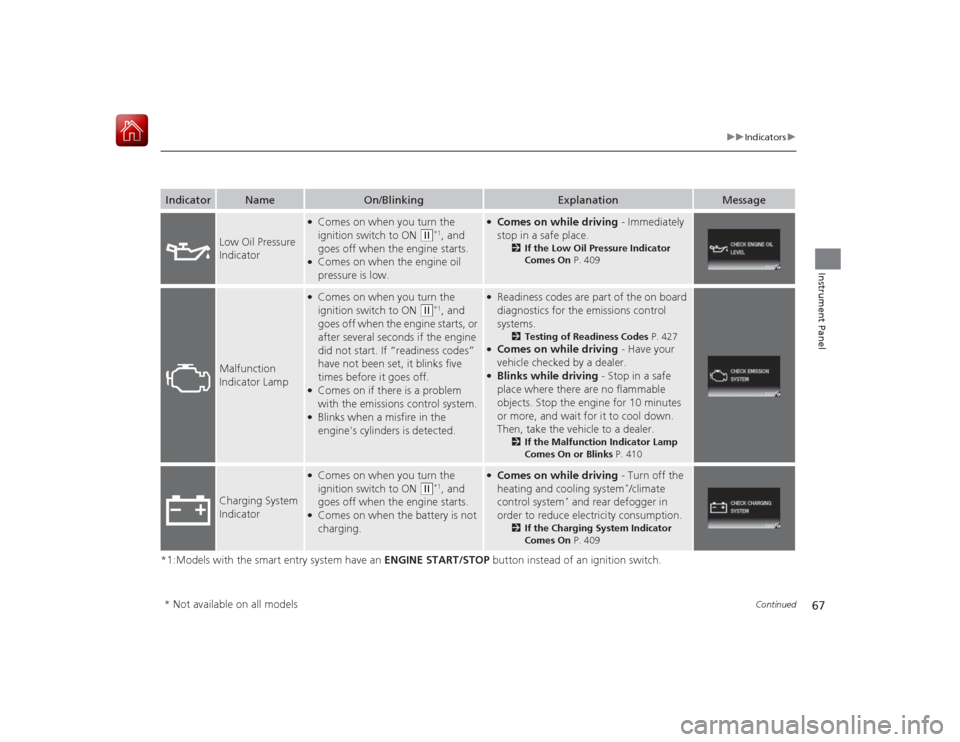
67
uuIndicators u
Continued
Instrument Panel
*1:Models with the smart entry system have an ENGINE START/STOP button instead of an ignition switch.Indicator
Name
On/Blinking
Explanation
Message
Low Oil Pressure
Indicator
â—ŹComes on when you turn the
ignition switch to ON
(w
*1, and
goes off when the engine starts.
â—ŹComes on when the engine oil
pressure is low.
â—ŹComes on while driving - Immediately
stop in a safe place.
2 If the Low Oil Pressure Indicator
Comes On P. 409
Malfunction
Indicator Lamp
â—ŹComes on when you turn the
ignition switch to ON
(w
*1, and
goes off when the engine starts, or
after several seconds if the engine
did not start. If “readiness codes”
have not been set, it blinks five
times before it goes off.
â—ŹComes on if there is a problem
with the emissions control system.â—ŹBlinks when a misfire in the
engine's cylinders is detected.
â—ŹReadiness codes are part of the on board
diagnostics for the emissions control
systems.
2 Testing of Readiness Codes P. 427
â—ŹComes on while driving - Have your
vehicle checked by a dealer.â—ŹBlinks while driving - Stop in a safe
place where there are no flammable
objects. Stop the engine for 10 minutes
or more, and wait for it to cool down.
Then, take the vehicle to a dealer.
2 If the Malfunction Indicator Lamp
Comes On or Blinks P. 410
Charging System
Indicator
â—ŹComes on when you turn the
ignition switch to ON
(w
*1, and
goes off when the engine starts.
â—ŹComes on when the battery is not
charging.
â—ŹComes on while driving - Turn off the
heating and cooling system
*/climate
control system
* and rear defogger in
order to reduce electricity consumption.
2 If the Charging System Indicator
Comes On P. 409
* Not available on all models